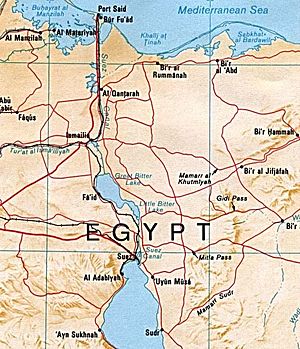
Back حرب الاستنزاف Arabic حرب الاستنزاف ARZ Guerra de Gastadura AST Zəiflətmə müharibəsi Azerbaijani ییپراتما ساواشی AZB আরব–ইসরায়েল সংঘর্ষ (১৯৬৭–১৯৭০) Bengali/Bangla Guerra de desgast Catalan Opotřebovací válka Czech Y Rhyfel Athreuliol Welsh Udmattelseskrigen Danish
| War of Attrition | |||||||
|---|---|---|---|---|---|---|---|
| Part of the Arab–Israeli conflict and the Cold War | |||||||
 The Israeli–Egyptian war of Attrition was centered largely on the Suez Canal. | |||||||
| |||||||
| Belligerents | |||||||
|
|
| ||||||
| Commanders and leaders | |||||||
|
|
| ||||||
| Strength | |||||||
| 275,000 (including reserves) |
Egyptian: 200,000 Soviet: 10,700–15,000[4] Jordanian: 15,000[5] PLO: 900–1,000[6][7] | ||||||
| Casualties and losses | |||||||
|
694[8]–1,424[9] soldiers killed 227 civilians killed[8] 2,659 wounded, from this 999 at the Egyptian front[8] 24[10]–30[11] aircraft |
Egypt: 2,882[12]–10,000[10] soldiers and civilians killed 6,285 wounded[13] 60[11]–114[14] aircraft lost PLO: 1,828 killed 2,500 captured[15] Jordan: 300 killed[16] 4 captured 30 tanks Soviet Union: 58+ dead[17] 5 aircraft Cuba: 180 dead 250 wounded[18] Syria: 500 killed[16] | ||||||
The War of Attrition (Arabic: حرب الاستنزاف, romanized: Ḥarb al-Istinzāf; Hebrew: מלחמת ההתשה, romanized: Milḥemet haHatashah) involved fighting between Israel and Egypt, Jordan, the Palestine Liberation Organisation (PLO) and their allies from 1967 to 1970.
Following the 1967 Six-Day War, no serious diplomatic efforts were made to resolve the issues at the heart of the Arab–Israeli conflict. The 1967 Arab League summit formulated in September the "three no's" policy, barring peace, recognition, or negotiations with Israel.[19] Egyptian President Gamal Abdel Nasser believed that only military initiative would compel Israel or the international community to facilitate a full Israeli withdrawal from Sinai,[20][21] and hostilities soon resumed along the Suez Canal.
These initially took the form of limited artillery duels and small-scale incursions into Sinai, but by 1969, the Egyptian Army judged itself prepared for larger-scale operations. On March 8, 1969, Nasser proclaimed the official launch of the War of Attrition, characterized by large-scale shelling along the Suez Canal, extensive aerial warfare and commando raids.[20][22] Hostilities continued until August 1970 and ended with a ceasefire.[23] The frontiers remained the same as when the war began, with no real commitment to serious peace negotiations.
- ^ Tucker, Spencer; Roberts, Priscilla (2008). The Encyclopedia of the Arab-Israeli Conflict: A Political, Social, and Military History. ABC-CLIO. p. 596. ISBN 9781851098422.
- ^ "The War: Lebanon and Syria". Dover.idf.il. Archived from the original on March 24, 2012. Retrieved March 12, 2013.
- ^ "The War of Attrition (1968–70)". mfa.gov.il.
- ^ Russian Aviation and Air Power in the Twentieth Century, Robin D. S. Higham, John T. Greenwood, Von Hardesty, Routledge, 1998, p.227
- ^ Fruchter-Ronen I, (2008), pp. 244–260
- ^ Morris (1999), p. 368
- ^ Wallach, Jedua; Ayalon, Avraham; Yitzhaki, Aryeh (1980). "Operation Inferno". in Evyatar Nur. Carta's Atlas of Israel, Volume 2
- ^ a b c Schiff, Zeev, A History of the Israeli Army (1870–1974), Straight Arrow Books (San Francisco, 1974) p. 246, ISBN 0-87932-077-X
- ^ Lorch, Netanel (September 2, 2003). "The Arab-Israeli Wars". Israeli Ministry of Foreign Affairs. Retrieved March 3, 2007.
- ^ a b Benny Morris, Righteous Victims: A History of the Zionist-Arab Conflict, 1881–2001, Random House (1999), page 362. ISBN 978-0-679-74475-7.
- ^ a b Nicolle and Cooper, 32–33
- ^ Saad el-Shazly, The Crossing of Suez. p. 195. ISBN 978-0-9604562-2-2.
- ^ Uri Bar, The Watchman Fell Asleep: The Surprise Of Yom Kippur And Its Sources. p.15. ISBN 978-0-7914-6482-3.
- ^ Insight Team of the London Sunday Times, Yom Kippur War, Doubleday (publisher) (1974) Page 42
- ^ Zeev Schiff, History of the Israeli Army 1870–1974, Straight Arrow Books (1974) ISBN 0-87932-077-X, page 246
- ^ a b Kober, Avi: Israel's Wars of Attrition: Attrition Challenges to Democratic States, pp. 80-81
- ^ "Книга памяти / Совет ветеранов войны в Египте". www.hubara-rus.ru.
- ^ Karsh, Efraim: The Cautious Bear: Soviet Military Engagement in Middle East Wars in the Post-1967 Era
- ^ Meital, Yoram (2000). "The Khartoum Conference and Egyptian Policy after the 1967 War: A Reexamination". The Middle East Journal. 54 (1): 64–82. JSTOR 4329432. Retrieved October 15, 2023.
- ^ a b Cite error: The named reference
dunstanwas invoked but never defined (see the help page). - ^ "Egypt Will Fight, Nasser Shouts". Pittsburgh Post-Gazette: 2. November 24, 1967.
- ^ Aloni, Shlomo (2004). Israeli Mirage and Nesher Aces. Osprey. pp. 46–53.
- ^ "Israel-Egypt Ceasefire Agreement - Text - English (1970)". ecf.org.il. Retrieved October 21, 2021.
© MMXXIII Rich X Search. We shall prevail. All rights reserved. Rich X Search